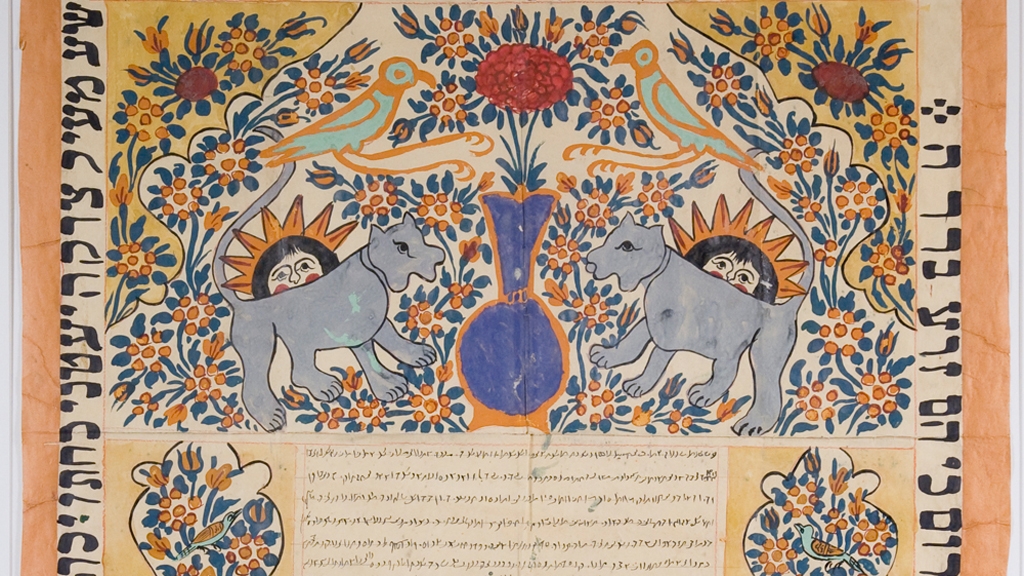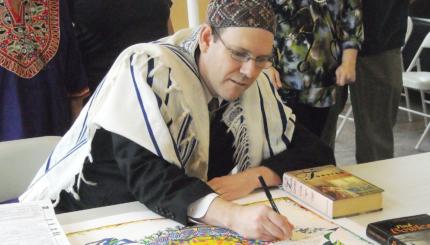Browse through any Judaica shop today and you’ll see evidence of an ever-growing trend: Judaic art has become more sophisticated, varied, and complex than ever before. Jewish artists are finding the medium of Judaic objects to be a wonderful canvas to infuse tradition with their original eye. Their creations include original ketubot (Jewish wedding contracts) integrating both sacred and secular symbolism and rituals objects for the home, like Shabbat candles and Kiddush cups created with a specifically feminist twist.
A Long Tradition
While many Judaica artists create cutting-edge work in both content and style, their work does not stand in a vacuum. It emerges from a long tradition of Jewish folk art.
Today, many of these artists are professionally trained and bring a fine arts sensibility to their Judaica work. This is a relatively new phenomenon. Only in the last few centuries have Jewish artists trained in the fine arts. For the greater part of Jewish history, most Judaica artists were untrained, and their art was not their life’s work, but was simply one form of devotion to God. Known today as “Jewish folk art,” the tradition of Jewish visual expression includes paper-cutting, creation of the mizrach and shivitti (two forms of decorative signs), and the art of micography (using words to create images). Looking with contemporary eyes at these primarily self-taught forms of expression offers inspiration and assurance that the visual arts hold a prominent place in Jewish civilization.
At first glance, any work of “folk art” may at first seem childish or naïve; what makes it great art is that at second glance, the art reveals depth and substance. Jewish paper cutting was, for centuries, more or less of a hobby of a primarily male, religious population. These men included rabbis, yeshiva teachers, and students, people who had time to use their hands even as they focused on study and discussion.
Paper-Cutting
Paper-cutting was an inexpensive art — no fancy materials were needed, just a scrap of paper, a pencil, a knife. At the same time, some artists used more expensive materials, such as parchment, resulting in paper-cut art better able to be preserved. The tradition of Jewish paper-cutting was borrowed by the Jews of the Middle Ages’ Christian and Muslim neighbors. It can be traced as far back as the 14th century, and it continued to play a major cultural role in Jewish tradition through the 19th and early 20th centuries.
The craft takes a simple art–cutting paper to create a design (think of making a snowflake in grade school)–and transforms it into an expression of devotion. The artist would take a line of text, from Psalms, for instance, and would strive to bring the imagery of the text alive in the paper-cut.
As time went on, paper-cutting became more esteemed, and soon paper-cut designs became connected with certain lifecycle events and holidays. Artists used paper-cutting to illustrate ketubot (marriage contracts), for example, and would create certain designs for the Jewish festivals of Sukkot and Shavuot. While Jewish literary tradition focused on the importance of words, the folk art tradition brought visual representations of words and ideas to life.
Using Art to Focus Attention
Artists often used paper-cutting to create a mizrach (which literally means “east”). The mizrach was a wall hanging for the most eastern wall of the Jewish home, reminding them which way to face while praying–toward Jerusalem–and directing the family’s thoughts to that holy city during prayer. In Eastern Europe, the mizrach was frequently an object not just of devotion, but also of beauty. Elaborate mizrachim (plural of mizrach), created by paper-cutting techniques adorned many Jewish homes. Though the intention of the mizrach was to serve a simple, religious function, the art of the mizrach shows the high regard that was paid to good craftsmanship and beautiful aesthetic sense.
Another example of Jewish folk art, dating back to the Middle Ages, was the creation of the shivviti (meaning “awareness.”). Similar to the mizrach in that its function was to focus attention, the shivviti would hang in the synagogue. Inspired by a line from Psalms, “Shivitti Adonai Lanegdi Tamid”– I am ever aware of the Eternal One’s presence”–the shivviti employed the Hebrew letters “yud, hay, vav, hay” which together symbolize God’s name. It is interesting to note that while it was forbidden to try to utter the name of God, the shivviti used these letters in an artistic design to represent God’s presence. The shivviti might include other Biblical phrases or lines from Psalms, but the focus of its design was always the letters “yud, hay, vav, hay.” The shivviti, like the mizrach, was often created by paper-cutting, although examples of shivviti created by embroidery, drawing, and other media do exist.
Micrography
Hebrew micrography takes the scribal art of calligraphy–used by scribes to write Torah scrolls and other sacred books–and creates images and symbols made up of words. Dating back to the ninth century, micrography uses a minute form of writing to create abstract patterns or form shapes, such as ritual objects or animals. Scribes in ancient Israel and Egypt were trained to write in very small letters–especially to create the scrolls that go inside a mezuzah or to write notes of commentary in the margins of Hebrew Bibles–and so used their specialized ability to create an original art form.
Micrography spread from the scribes of the Near East to the Jewish communities of the Diaspora–to the Sephardic communities of Spain and Portugal, as well as to the Ashkenazic communities of Eastern Europe. It was an art form that was taught from one scribe to another, each scribe adding his own innovation and mark. By the 17th century, micrography was used to embellish all kinds of Judaica: ketubot, omer calendars (used to count the days between Passover and Shavuot, a period known as the omer), decorations for the Sukkah, and wall-hangings for the home. Later, as the Jewish world spread overseas–to North and South America and returning to the Land of Israel–scribes took the art of micrography with them and spread their work in the new lands.
As with paper-cutting, micrography’s emphasis is on sacred words. The art of micrography is about playing with those words–beautifying those words, illuminating them, drawing the eye to them in a fresh way. Also like paper-cutting, it is an art form keeping the importance of Jewish sacred literature in tact. In fact, many scribes have used micrography as a kind of internal art–creating small samples of micrography within Bibles, ornamenting such scriptures as the Psalms. As the art of micrography continues to grow today throughout the Jewish world, it is still most often sacred words that are used to create the visual patterns or designs.
The Jewish folk arts provide a fascinating look at the values of Jews of yesteryear. While much of Jewish culture focused on the world of books, law, and worship, the existence of folk arts indicates that creativity and visual expression were also valued and appreciated. Though contained within a narrow framework of religious devotion, these art forms can nonetheless inspire both the observant and secular person today. That this art was created by untrained artists–who used simple tools to create works of deeply-felt expression and faith–is especially inspiring.
When many parts of a vibrant, thriving Jewish culture were decimated in Eastern Europe during the Holocaust, the tradition of Jewish folk art became part of that vast cultural loss. However, in recent years, there is a growing renewal of interest in Jewish folk arts, similar to the revived interest in Yiddish language and klezmer music. Israeli scholars Joseph and Yehudit Shadur have written two definitive guides about Jewish paper-cutting: Jewish Papercuts: A History and Guide and Traditional Jewish Papercuts: An Inner World of Art and Symbol. Their work inspires Judaic artists today, many of whom are reclaiming this lost art and incorporating it as part of their creative process in making ketubot and other sacred art.
Likewise, the art of making mizrachim and shivviti are also experiencing a renaissance as a form of artistic expression. Artists are exploring these forms with mosaic, fiber art, collage, and other techniques. Micrography is also a thriving art, with calligraphers using this form of word-art in fresh and surprising ways.
No longer seen as “outsider” or “simple” art, these forms of Jewish folk art are respected and regarded as part of a long-held Jewish aesthetic tradition. These art forms now live on with a new generation of Jewish visual artists world-wide, evolving with each new artist who works with them.
Adonai
Pronounced: ah-doe-NYE, Origin: Hebrew, a name for God.
Kiddush
Pronounced: KID-ush, Origin: Hebrew, literally holiness, the blessing said over wine or grape juice to sanctify Shabbat and holiday.
mizrach
Pronounced: meez-RAKH, Origin: Hebrew for east, refers to a wall hanging designating this direction to help people pray facing east, or toward Jerusalem.
Sephardic
Pronounced: seh-FAR-dik, Origin: Hebrew, describing Jews descending from the Jews of Spain.
Shabbat
Pronounced: shuh-BAHT or shah-BAHT, Origin: Hebrew, the Sabbath, from sundown Friday to sundown Saturday.
Sukkot
Pronounced: sue-KOTE, or SOOH-kuss (oo as in book), Origin: Hebrew, a harvest festival in which Jews eat inside temporary huts, falls in the Jewish month of Tishrei, which usually coincides with September or October.
Torah
Pronunced: TORE-uh, Origin: Hebrew, the Five Books of Moses.
yeshiva
Pronounced: yuh-SHEE-vuh or yeh-shee-VAH, Origin: Hebrew, a traditional religious school, where students mainly study Jewish texts.



